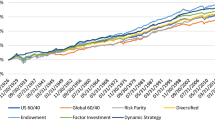Abstract
This paper re-examines and extends the findings of Bond et al., Journal of Real Estate Finance and Economics, 34, 447–461, (2007) who consider the theoretical model of Lin and Vandell, Real Estate Economics, 35, 291–330, (2007) to determine the extent to which individual real estate asset return characteristics caused by marketing period risk disappear in a large, diversified real estate portfolio. The effects of marketing period risk are found to disappear in the limit with growth in the size of the portfolio, with ex ante variance approaching ex post variance, but only if the portfolio consists of nonsystematic risk alone, in which case both approach zero. The marketing period risk factor (MPRF), representing the ratio of ex ante to ex post variance, however, does not in general approach zero in the limit, in fact could increase or decrease depending upon the illiquidity characteristics of the individual assets and the magnitude and degree of correlation among individual property returns and marketing periods. The results suggest that even large institutional real estate portfolio managers must consider the illiquidity present in their portfolios and cannot assume that its effect will be diversified away.
Similar content being viewed by others
Notes
Note that the formula appears in Eq. 6 of Theorem 1.
The terms in Equation 1 are defined as follows: t is the holding period; s p is the marketing time of the portfolio; λ p is the expected marketing time of the portfolio; μ p and \({\text{ $ \sigma $ }}_{\text{p}}^{\text{2}} \) are expected return and variance of the portfolio return per unit of time. N is the number of property in the portfolio.
We do not assume that each property has the same return distribution, because empirical evidence suggests that higher expected TOM is likely to be associated with a higher expected return (Glower et al. 1998).
References
Bond, S., Hwang, S., Lin, Z., & Vandell, K. D. (2007). Marketing period risk in a portfolio context: Theory and empirical estimates from the UK commercial real estate market? Journal of Real Estate Finance and Economics, 34, 447–461.
Black, F., & Scholes, M. (1973) The pricing of options and corporate liabilities. Journal of Political Economy, 81, 637–659.
Glower, M., Haurin, D., & Hendershott, P. (1998). Selling price and selling time: The impact of seller motivation. Real Estate Economics, 26, 719–740.
Hull, J. (2002). Options, futures, and other derivatives (5th ed.). NJ: Prentice Hall.
Lin, Z., & Vandell, K. (2007). Illiquidity and pricing biases in the real estate market. Real Estate Economics, 35, 291–330.
Merton, R. (1973). Theory of rational option pricing. Bell Journal of Economics and Management Science, 4, 141–183.
Ross, S. (2002). A first course in probability (6th ed.). NJ: Prentice-Hall, Inc.
Acknowledgements
We wish to thank editor James Kau at the Journal of Real Estate Finance and Economics, Ping Cheng at Florida Atlantic University and Paul Obrecht at Fannie Mae for their insightful comments and suggestions. All errors remain our own. The views expressed in this article are our own and do not necessarily represent the views of Fannie Mae.
Author information
Authors and Affiliations
Corresponding author
Rights and permissions
About this article
Cite this article
Lin, Z., Liu, Y. & Vandell, K.D. Marketing Period Risk in a Portfolio Context: Comment and Extension. J Real Estate Finance Econ 38, 183–191 (2009). https://doi.org/10.1007/s11146-007-9086-y
Received:
Accepted:
Published:
Issue Date:
DOI: https://doi.org/10.1007/s11146-007-9086-y




